How To Work With Large Data Sets In Excel
Ever wanted to use Excel to examine big data sets? This tutorial will show you how to analyze over 300,000 items at ane time. And what better topic than baby names? Want to come across how popular your name was in 1910? You can practice that. Want to detect the perfect name for your infant? Hither's your chance to do it with data.
At that place are professional data analysts out there who tackle "big data" with complex software, only it's possible to do a surprising corporeality of assay with Microsoft Excel. In this case, we're using baby names from California based on the U.s. Social Security Baby Names Database. In this tutorial, y'all'll non only learn how to dispense big data in Excel, yous'll larn some disquisitional thinking skills to uncover some of the flaws within databases. Equally yous'll run across, the Social Security database, which goes back to 1880, has some weird and wonderful anomalies that we'll talk over.
This tutorial is for people familiar with Excel: those who know how to write, copy and paste formulas and make charts. If yous rarely venture away from a handful of carte du jour items, you lot'll learn how to utilise built-in Excel features such equally filters and pin tables and the extremely handy VLOOKUP formula. This tutorial focuses on what'southward called "exploratory analysis", and will clarify the steps to take when you first confront a huge chunk of data, and y'all don't know in advance what to expect from it. We'll also show y'all how to employ these tools to observe the flaws in your information prepare, so y'all can make appropriate inferences. If you want to improve your Excel chops with some big data exploration, you lot're in the correct identify.
Annotation: This tutorial uses Excel 2022. If you lot're using a unlike version, y'all may discover some slight differences as you lot go through the steps.
Download the state-specific information from http://www.ssa.gov/oact/babynames/limits.html. You lot'll find a file named namesbystate.goose egg in your download folder. Excerpt the California file: CA.TXT. (In Windows, you tin just elevate the file out of the annal.)
Launch Microsoft Excel, and open up CA.TXT. If y'all don't see the file in your dialogue box, you may have to cull Show All Files in the dropdown box adjacent to the file proper name box.
In the Text Import dialogue box, choose Delimited, and so Next, so Comma, so Finish. This tells Excel to care for commas equally cavalcade separators. Save your file as an Excel Workbook file called CA Baby Names.xlsx. Your workbook should look similar to this:
Annotation: the number of rows in various parts of this tutorial are based on the Social Security Baby Names file going until the end of 2022. Depending on when you are doing this tutorial, the files may have been updated with data from later years, so the number of rows may be larger. Proceed this in mind if the final row specified in this tutorial is slightly less than what yous see on the screen.
Select the first column, A, and delete it; all of your data in this file is from California, you don't need to waste matter figurer resource on that information. Insert a new row above Row one, and type cavalcade headers: Sex, Year, Name and Births. Your workbook should now look like this:
Filters are a powerful tool to drill down into subsets of your data. Press Ctrl-A or Cmd-A on Mac (from now on, I'll just write Ctrl) to select all your data, then in the Home Tab select Sort & Filter, and Filter. Your data column headers now take triangles to the correct of each cell, with dropdown boxes. Allow's say you wanted to await up only the first proper noun 'Aaliah'. Click the triangle to filter the Proper name column, click the Select Allcheckbox to deselect everything, so click the checkbox adjacent to 'Aaliah'. Y'all should encounter the following:
Sanity Checks
When doing data analysis, it'south essential to take a pace back every now and and so and enquire, "do these results make sense?" This is particularly important when you are changing the values of cells in an Excel Spreadsheet; if yous make a error and change your data, information technology can be difficult to rails down the error later.
Just sanity checks tin can also exist used to check the state of the information equally it came to you. Use the filter to select only the name 'Jennifer', and have a look at the results. The following things should stand out:
- On your style downwards the listing, there were quite a few names that were about, but not quite, spelled 'Jennifer', like 'Jennfier' and 'Jenniffer'. Some of these are alternate spellings given by parents who want an unusual name, but it's possible some are typing errors past the clerks who recorded the data. There's no style to determine which are errors and which are intentional, simply you should deport these possibilities in listen. Datasets are rarely perfect, and this is especially true the larger they become.
- There are quite a few boys named 'Jennifer' in this data. Again, it's possible some adventurous parents gave boys a traditionally female proper noun, only if yous expect through names of medium popularity or ameliorate, you'll find a modest percentage is ever of the other sexual activity. This odd consistency makes it probable that a practiced proportion of these are too due to errors in the dataset. If you lot wanted to just consider the girls named 'Jennifer', you lot could filter the Sex column.
Summarize with Pin Tables
The Pin Tables feature is a powerful tool that allows yous to manipulate and explore the data. Here, we'll use it to detect out how many names and births are in the database for each twelvemonth. First, select columns A through D, and then they are highlighted. Then click the Insert Tab'southward leftmost button, PivotTable. In the dialogue box that appears, brand sure the Table/Range radio button is selected and the accompanying text box reads CA!$A:$D (if you selected columns A through D correctly earlier, this should exist the default. If not, type it in exactly as written. The CA is the name of your data worksheet, taken from the CA.TXT filename you started with).
In the lesser of the dialogue box, make sure the New Worksheet radio button is highlighted, then click OK. A new worksheet appears, named Sheet1 – right click on the Sheet Tab and rename it something like'Pivot', since it's a skilful habit to always have descriptive sail names instead of uninformative default ones. Your screen should look similar this:
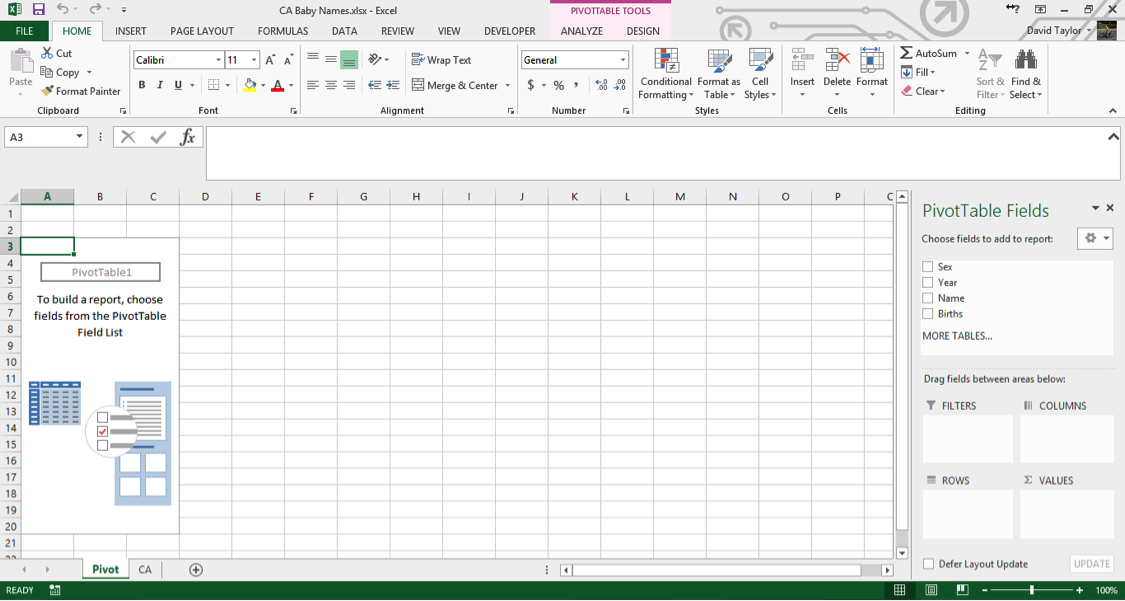
If you've never used an Excel pivot table earlier, it takes some getting used to, merely it'south not likewise complicated, and it'southward well worth the attempt. In one case you lot've followed the instructions here, nosotros recommend playing effectually with pivot tables to go to know them better.
In the menu on the right, click the checkbox side by side to the Twelvemonth field. Twelvemonth now automatically appears in theROWS box on the bottom left of that bill of fare, which is exactly what you want. At present click the Births checkbox, and drag the Births that appears in ROWS to the right into VALUES.
Your screen will now await similar this:
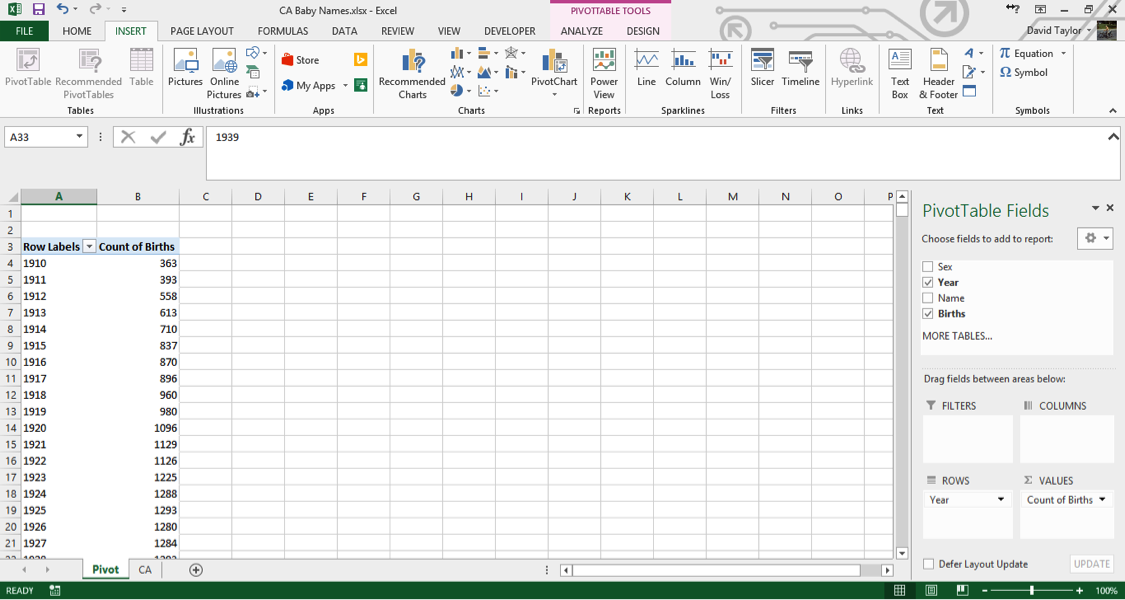
A few things should be noted here: the title of the rightmost column, Count of Births, is a piffling unclear. In data analysis, 'count' e'er means the number of rows in a category, regardless of the value in the cells in that row. And so what yous are seeing here is: for each year in the database, the number of unique male names plus the number of unique female names. You tin come across that every bit time progresses from 1910 to 1927, there are more names per year. Does this mean parents are picking more diverse names for their children? Possibly – that's what you want to notice out with further analysis.
Clarity and explicitness are of import. Whenever you create a computer certificate, you should do so with the philosophy that if y'all open it over again six months from now, you will immediately understand what you're looking at. With that in mind, click on the cell where information technology says Count of Births and modify it to Unique Names.
Bear in listen, when you're working with pivot tables, the card on the correct will disappear someday you don't accept a jail cell of the pivot table to the left selected. If that happens, just select a cell in the tabular array, and you're good to go.
Add a PivotChart
When it comes to quickly understanding data, nada beats a chart. (Almost people telephone call charts "graphs", but technically a graph is a complicated network visualization that looks cypher like what you'd wait, so Excel properly calls them charts.) Our visual senses are powerful, and are able to immediately understand patterns and trends when they are abstracted into the form of bars and lines.
Brand sure your pivot tabular array is selected, then in the Insert Tab, click PivotChart. In the next dialogue box, the default is a bar chart; this volition work, simply information technology will be easier on the eyes if you select a line nautical chart, then click OK. You may find it easier if you resize the chart so that the bottom x-axis shows intervals of five and 10 years, since we tend to think of years in terms of decades. Your screen should wait like this:
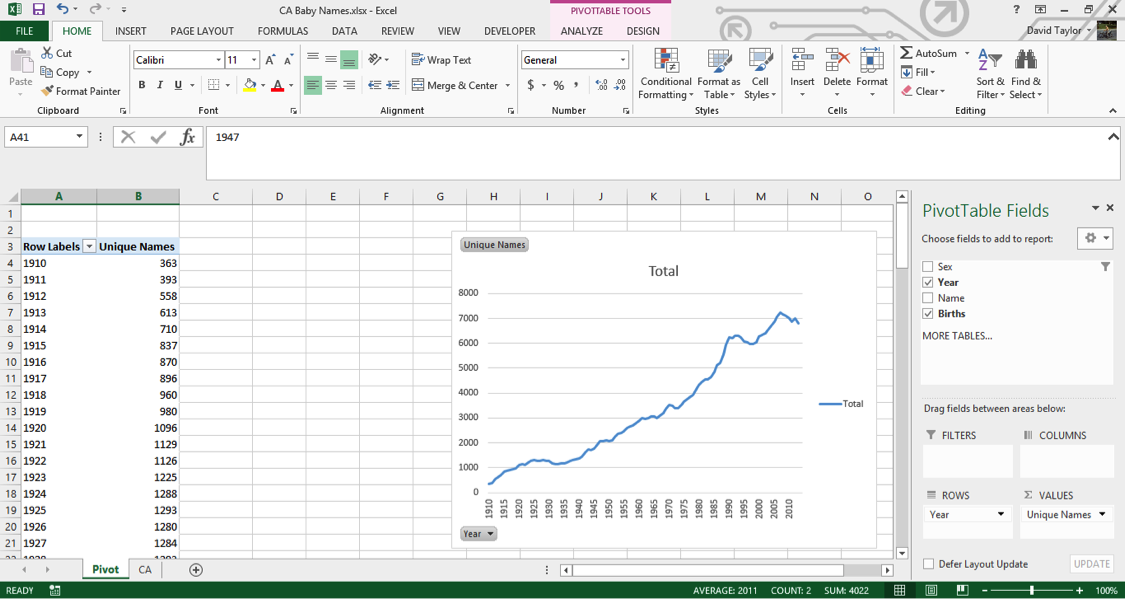
Again, we're seeing an increase in the number of unique male names and unique female names per yr. Only what if you want to know the number of births themselves? With Excel's pivot table, that'south easy to do. You could modify your unmarried cavalcade, but it is unremarkably more informative to add a new column so you can compare, contrast and calculate.
In the right-hand menu, under Choose fields to add to written report, drag the bold checkboxed Births downwardly to theVALUES box in the lower correct. You at present have two columns, Unique Names and Count of Births (Excel has given this column the same default name it did before). Click the downwards-facing blackness triangle to the right of Count of Births in the VALUES box, and select Value Field Settings from the context menu (the card that pops up when y'all right-click). In the resulting dialogue box, alter the highlighted Count to Sum.
Your new column's header name is wrong, so click in its cell and type Number of Births (just "Births" would accept been fine, just Excel won't let you give a pin nautical chart column the same proper noun as one of the columns information technology's based on). A new line has been added to your pivot chart, simply because the number of births is so much greater than the number of names, information technology's compressed downward to about the x-axis. The solution for this is to put it on a secondary y-axis. Click on the compressed series so it's selected. Correct-click and choose Format Data Series from the context carte du jour. Then, choose the Secondary Centrality radio button, and click the 10 in the peak right of the Format Data Series panel to dismiss it. At present you should run across this:
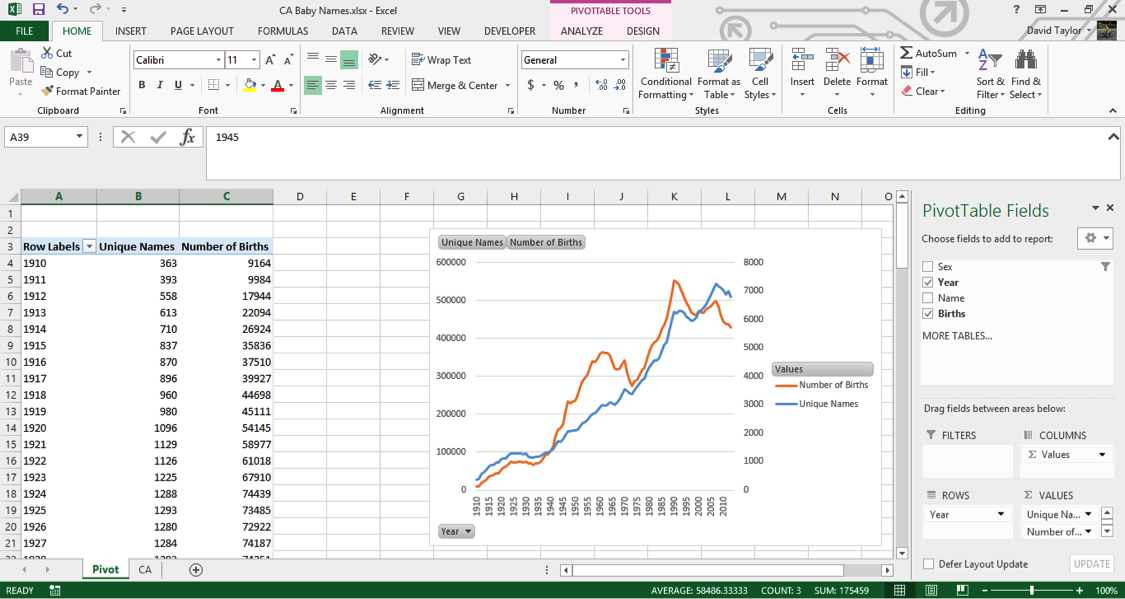
If you see something different, don't panic. Go back and follow the steps closely, using this screen as a guide to what yous should come across.Let'south study the shapes of the Unique Names line (in blue in the figure above) and the Number of Births line (in orangish in a higher place). They both have a generally increasing direction, as you would expect, and often move in tandem (particularly from 1910 to 1935 and 1975 to 2000). The number of births increases chop-chop during the Infant Boom starting effectually 1940, peaks effectually 1960, and peaks again around 1990 and 2005.
Some other Sanity Check
Whenever possible, it's a good idea to go a 2d opinion about data: you weren't involved in its collection or curation, and then you can't vouch for its accuracy. Just considering a government department publishes a dataset, doesn't hateful you should trust everything in it 100%. (Please believe me, I speak from feel!)
In this case, it'southward like shooting fish in a barrel to double-bank check. Googling the terms 'California birth rate' leads united states to the California Section of Public Health, and documents such equally this one —http://www.cdph.ca.gov/information/statistics/Documents/VSC-2005-0201.pdf — which prove the same trends (after 1960, anyway, where the CDPH data starts) as in the Babe Names data. Nevertheless, information technology appears that the overall number of births is greater in the CDPH records than in the dataset nosotros're working on. For example, in 1990, the Babe Names information shows nearly 550,000 births, while the CDPH shows 611,666.
That's why it's a good thought to know your dataset, and read up about how it was nerveless and what it contains (or what it leaves out). The background information given by the Social Security Administration about this dataset at http://www.ssa.gov/oact/babynames/background.html andhttp://www.ssa.gov/oact/babynames/limits.html points out that any names with fewer than five births is left out, to protect the privacy of the names' holders. Then it's plausible that the 60,000 missing births split amidst people who shared their name with fewer than 5 other people.
Explore your data and uncover insights
The pivot table and chart nosotros've created are based on all of the data. However, there's a natural and obvious partitioning within the topic of infant names: male and female names. For ane matter, more boys are born than girls (about iv% to eight% more, due to biological and environmental factors). Also, there are unlike social pressures on parents when naming boys and girls; nosotros'll meet testify of this soon.
Luckily, with pivot tables, it'southward easy to dissever out the sexes. Just elevate the Sex field proper name next to the checkbox in the upper correct down to the COLUMNS box. Click the filter icon at the right of the new jail cell named Column Labels at the top of the pivot chart. Make sure F and M are selected, but (blank) is not – there are no blank values for Sex in this dataset, which yous could easily verify by looking at the column totals with (blank) selected.
Where yous had ii columns earlier, now yous take six: Unique Names and Number of Births for females, males and both together. Here is what y'all should come across:
(Annotation: I clicked in a non-pivot table cell and moved the chart over so everything fits on ane screen.)
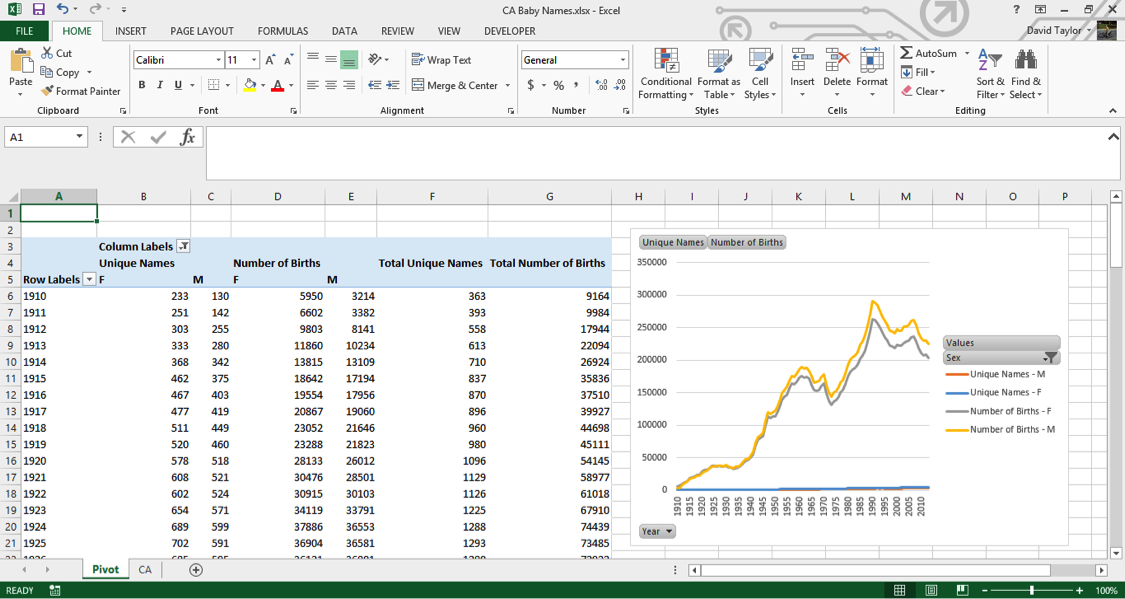
Unfortunately, your pivot chart has lost its secondary axis. You could become back and reassign both Number of Birth lines to the secondary axis, just here is where it's a good idea to stop using pivot tables and copy everything into a regular Excel spreadsheet. Why? Pin tables are powerful, simply they're non flexible. You tin add calculated columns, simply it's needlessly complicated. Pivot charts are fifty-fifty more limited: they will ever testify all the data in a pivot table. For example, if y'all wanted to limit the chart to but female names, or merely totals, nosotros'd take to change the pivot table itself.
So highlight columns A through G and copy them. And so, create a new worksheet, and right-click in cell A1, and select Paste every bit Values (or just printing the 'V' key). Resize the columns and so all the text fits, and rename the sheet Diversity (since that's what we'll be looking at). 'Multifariousness', by the manner, is simply the boilerplate number of names per birth. Its maximum possible value is ane, which would only happen if every infant built-in had a dissimilar proper name.
You should encounter this:
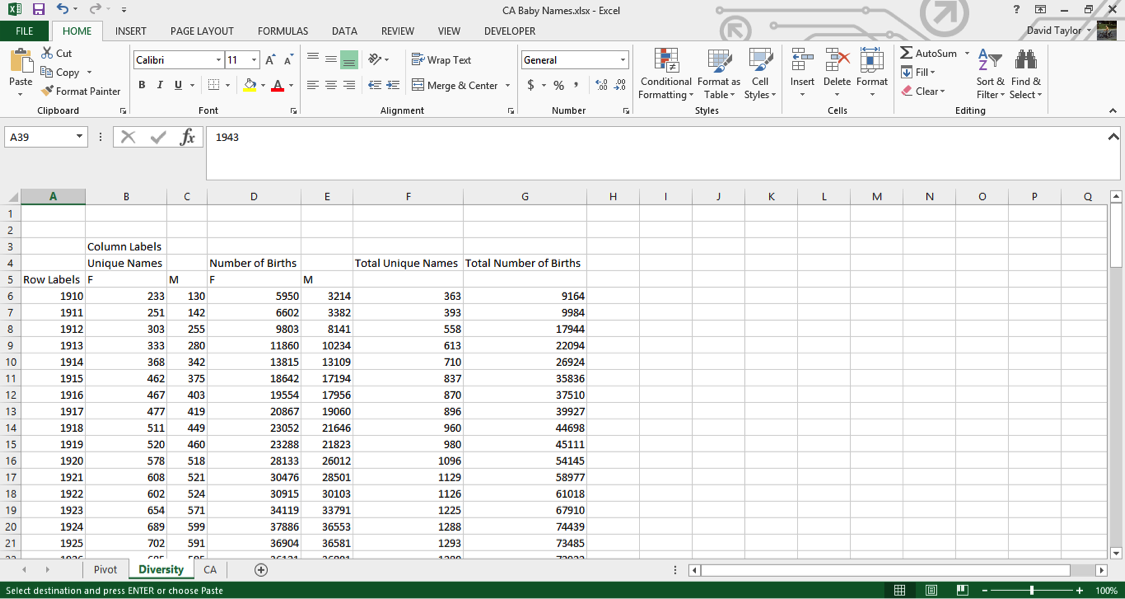
We're not interested in the totals anymore, and then go alee and delete columns F and G (this will give us more screen real estate). Supplant them with Variety in F4, F in F5 and M in G5, and in cell F6 blazon the formula=B6/D6. Re-create this cell, then select cells F6:G109 and paste. At the bottom of your spreadsheet, in Row 110, there are totals. Y'all should delete these, because they're potentially confusing, and information technology doesn't make sense to add together this kind of data for all years.
Now you're fix to add a chart. Select cells A5:A109, printing Ctrl/Cmd, and select cells F5:G109 (the female and male variety ratios, plus the column headers, F and K). And then in the Insert Tab select the scatter chart with straight lines, equally shown here:
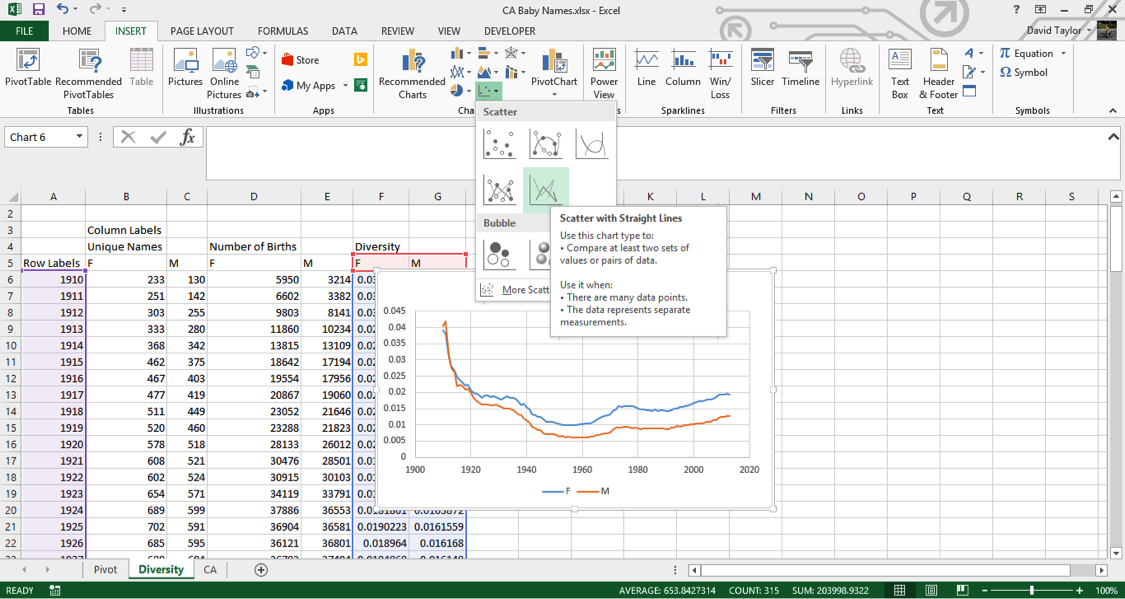
You lot should always label the axes of charts, and so with the nautical chart selected, employ the DESIGN tab and add together these features. (In Excel 2022, click on the Add together Nautical chart Element button at the left; the procedure is slightly unlike for other version of Excel). Proper noun the ten-axis Years and the y-axis Names per nascence and, while you're at it, change the nautical chart title to Variety.Ignore the first half of the graph for now: let's look at 1960 to present. As 1 would expect from anecdotal experience, there is more diversity in names now than in that location was l years agone. In add-on, female names are more than diverse than male names. Peradventure parents want their girls to stand out more than? It's interesting that the changes in multifariousness tracks pretty closely between the sexes. This suggests that the divergence is due to something intrinsic to the deviation between girls' and boys' names, not momentary trends. Perhaps the caption is unproblematic: there is more than diversity in girls' names considering there are more spelling variations in girls' names, like 'Ann' and 'Anne' and 'Anna'.
The train of idea outlined above illustrates the kind of mindset needed in exploratory data assay. Insights come up from looking beneath the surface and the obvious estimation, by questioning everything (including the data itself!), and by considering all possibilities.
With that in mind, take a look at the graph from 1910 to 1960. The maximum amount of name variety happens in the get-go years of the data. Does this seem plausible to yous? Were parents giving their kids wild and unique names during World War I at twice the charge per unit as today?
If at that place's something that doesn't make intuitive sense in the information, it'southward time for a sanity check. A good strategy is to check something else that, if the data is authentic, should be true. Homo sex ratio at birth was mentioned above: it should ever be between 103 and 108 boys born per 100 girls born. That seems like a proficient place to start.
Decide Of import Ratios
You can merely add more columns to the Diverseness spreadsheet. Move the chart out of the way to make room.
Call the new group of columns Sexual activity Ratio, and write 3 column labels in cells H5:J5 — Actual, Minimum and Maximum. Type the formula =100*E6/D6 into cell H6, and the numbers 103 and 108 in cells I6 and J6, respectively. Copy the contents of H6:J6 and paste into cells H7:J109.
Now to make the nautical chart. Select cells A5:A109 (which contain the years), hold down Ctrl/Cmd and select your new data in H5:J109. In the Insert tab, insert a scatter chart with lines as yous did higher up. Add a title and centrality labels. Yous should reformat the y-centrality, and so that y'all can visualize the data more conspicuously. (Ordinarily you want the y-axis to become all the style to null, only in this instance the y-axis can't perchance go down to zero (if there were no boys born, the human race would die out, correct?) Select the numbers on the y axis, right-click and choose Format Axis from the context menu, in the resulting dialogue box type 50 in Minimum and 120 inMaximum and click OK.
Here is what you should meet:
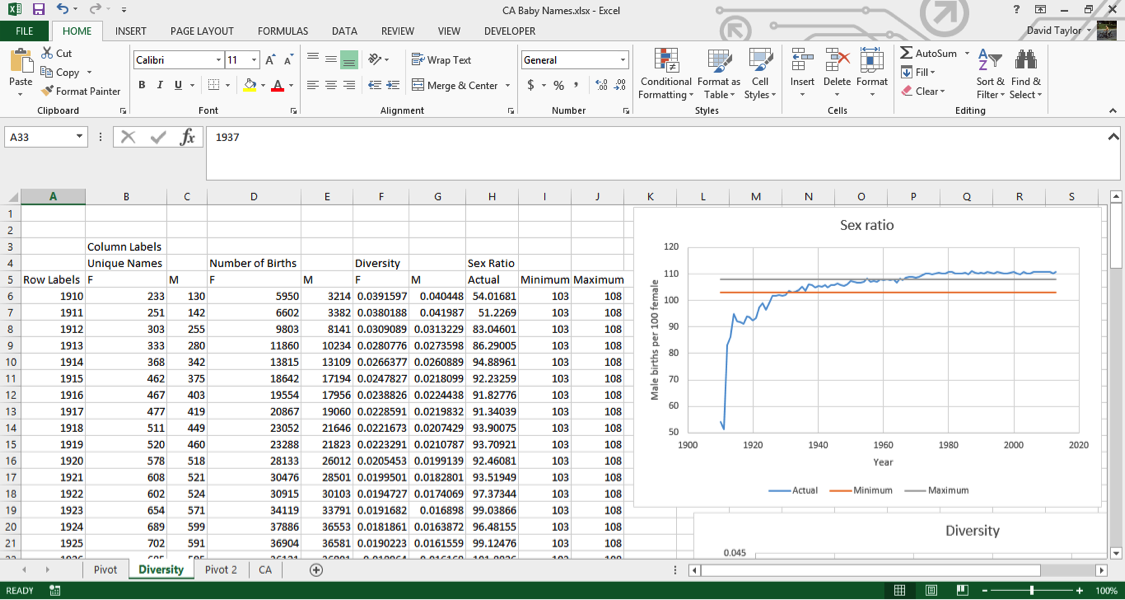
As you can clearly encounter, this data does not display the accepted sex ratios for humans. In fact, in the first few years it's way, way off. In the 1910s, at that place are only half as many boys as girls beingness born.The reason for this is quite simple, and unfortunate. If yous look at the landing page for this dataset athttp://www.ssa.gov/oact/babynames/, y'all tin see the U.South. Social Security Administration calls it a babe names dataset, and even has graphics of babies, merely the fact is, many of these names are not of babies: they're names of adults, and not fifty-fifty a representative sample of adult Americans.
If you wait at the Wikipedia entry for History of Social Security in the United States at https://en.wikipedia.org/wiki/History_of_Social_Security_in_the_United_States, you'll come across that Social Security only started in 1937. Yet your information goes dorsum to 1910, and for some other states information technology goes back every bit far as 1880. How can that exist? Well, those with a 1910 nascence year were at to the lowest degree 27 years old when they applied for Social Security. They applied, at the primeval, in 1937, and gave their birth year. This means people who died earlier the age of 27 are automatically excluded from the information (and infant and childhood mortality was far higher in the 1910s than information technology is today.) Also, Social Security was not a universal program and then as it is today. Merely those on a list of accepted occupations could join, which in practice, meant middle-course white people, so there is a social and ethnic bias to the dataset before the rules were relaxed in the 1950s.
Why are there more women than men in the early on years? Considering women live longer than men. They had less risk of dying before they could apply for Social Security, and outlived their husbands which meant they needed to apply in their own name in guild to receive their husbands' benefits.
It'south worth pointing out that it was unusual for Americans to give babies a Social Security number at all before 1986. That's the year the IRS started requiring them to claim a kid every bit a tax deduction. Earlier that time, it was usual for people to utilise for a Social Security number when they filed their own first revenue enhancement return, usually in their late teens.
Finally, why is the sexual activity ratio in the dataset above normal values starting around 1970? This 1 is easier to effigy out, because information technology'southward something you saw in the Variety graph. There are more girls' names than boys' names, and the dataset leaves out names belonging to fewer than five people for privacy reasons. That ways that more girls' names than boys' names are excluded from the dataset, so the ratio of boys to girls is a little higher.
Does this mean this dataset is useless? Admittedly not. All datasets accept strengths and weaknesses. The important thing is knowing what they are, so you don't draw unwarranted conclusions. (For example, you would probably hesitate to declare the top boys' names of 1910, just you'd have a lot more confidence in 2000.) With that in listen, allow'south do some more common analyses of the data, and at the cease, you'll exist able to see what it means for a 'babe names' dataset to really contain adults names.
Graph individual data points and trends
When you take information that is naturally divided into subcategories (in this example, years), information technology's a skilful idea to summate some statistics only in terms of that subset. For example, if you wanted to calculate the #1 names overall, it would be difficult to do that for the entire dataset, because there are more births in the 2000s than in the 1910s, so in exercise the result would be the "#ane name overall, but mostly present."
It makes a lot more sense to compare, for each row, the percentages of births of that proper name and sex that year to all births of that sex that year, and rank them. (For case, this will allow you lot to determine the popularity of the name 'Evelyn' relative to 'Margaret'—and every other name.) Here's how you do it.
Get back to your CA worksheet. The information, every bit downloaded, should already exist sorted the way you need information technology, but you lot should never take such things for granted. Select columns A:D, in the Domicile tab click the Sort & Filterbutton on the right, choose Custom Sort and utilise the Insert button to have three rows of criteria. Make these criteria Sex A-Z, Yr Smallest to Largest and Births Largest to Smallest as shown in the following figure, then click OK:
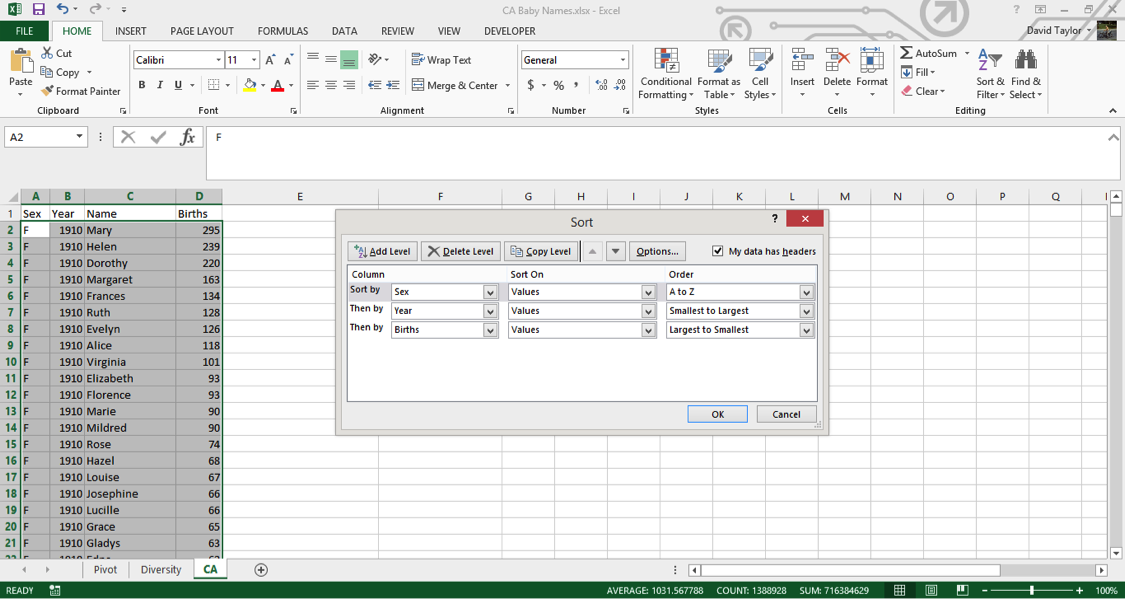
At present y'all tin add your new columns. Blazon new headers in E1 and F1: % of Births (same sex & year) and Rank (same sex & year), respectively. These column names might strike you lot as a little long, but it'south best to err on the side of clarity. If someone else has to look at and translate your work, or even if you have to return to it weeks or months later, information technology's all-time that everything tin can be understood equally easily as possible.
For your % of Births cavalcade, the concept is piece of cake: divide the number of births in that row, e.thou. 295 for Mary in 1910, by the full number of births of that sex and year, e.g. female births in 1910. Where can you find that information? In the pin tabular array you made at the beginning of the tutorial. Yeah!
Take a look at that pivot tabular array. The information y'all need to admission is in Columns D to East is. Luckily Excel has a few different functions you can apply to look up data in other worksheets; the easiest is the VLOOKUP office.
Go back to the CA worksheet and type the following into cell E2:=D2/VLOOKUP(B2,Pin!$A$vi:$E$109,IF(A2="F",4,5),FALSE)
If you're non familiar with the VLOOKUP role, hither's a breakdown of all of the arguments:
- D2: that's the number of births for Mary in 1910, which you'll divide past all female 1910 births.
- B2: that'due south the year you lot want to look up, in this instance 1910.
- Pin!$A$half-dozen:$E$109 tells the part to wait in the range of the Pivot spreadsheet with the years in the leftmost cavalcade and the full births, female and male person, in the two rightmost columns. This is what will be matched with the value in B2. The dollar signs are important. They tell Excel not to motility the lookup range down as you copy the formula down.
- IF(A2="F",4,5) tells the office what column to wait in for the results. If your row is a female name, it will wait in Cavalcade iv, otherwise Cavalcade five.
- Fake tells the office to render an fault if it tin't find the yr in the Pin worksheet. This shouldn't happen, just it'due south good to exist explicit here, and so that if something goes wrong, you'll know about it!
You should see the value 0.049579…. Copy this cell and paste information technology into every cell of Column Eastward below it. It might accept your computer a second or two (or iii or four…), depending on how powerful information technology is, to summate all of these values (there are over 300,000 of them, after all). To avoid having to wait for recalculations in the future, select all of Column E, copy it, and Paste equally Values. This is safe to do because you tin exist confident the underlying values being calculated volition not change in the future.
1 of the good features in Excel is that it can display percentages without changing the underlying value. In other words, you don't need to multiply your results past 100, and and then split by 100, if you want to employ them in a adding. Select Column E and use the Number Grouping on the Home tab to change the formatting to percentage with three decimal places.
Now is a practiced time for a sanity check. In whatever blank cell, type the following: =SUMIFS(E:E,A:A,"F",B:B,1910). This tells the office to add together the values in Column East only for those rows where Column Acontains F and Column B contains 1910. The result should be 1, i.e. 100%. If you replace F with M and/or 1910 with any year in the dataset, the value should always exist ane. At present that the integrity of your data has been verified, you tin delete that prison cell.
Now you can add the values in the ranks column. There are ways to utilize Excel functions to calculate ranks of subsets, but they're complicated and slow. Since you lot'll be pasting equally values later anyway, why not do it the quick and easy way? All that is required for this method is that the data be properly sorted, and you did that before.
In cell F2, type the following: =IF(B2<>B1,1,F1+1). This tells Excel to kickoff counting ranks when there is a change from row to row in the Year Cavalcade B. (If in that location is a change in the Sex Column A, there volition besides be a change in the Year column because of the style you sorted the worksheet earlier.) Excel will give the most common name a rank of ane because earlier you lot sorted the worksheet and so that births are in descending social club. Wherever there isn't a change in the Yr column, Excel increments the rank, i.e. one, 2, 3, four, …
Copy F2 to the whole range of Column F, then copy the whole cavalcade and Paste as Values. Finally, your worksheet should look like this:
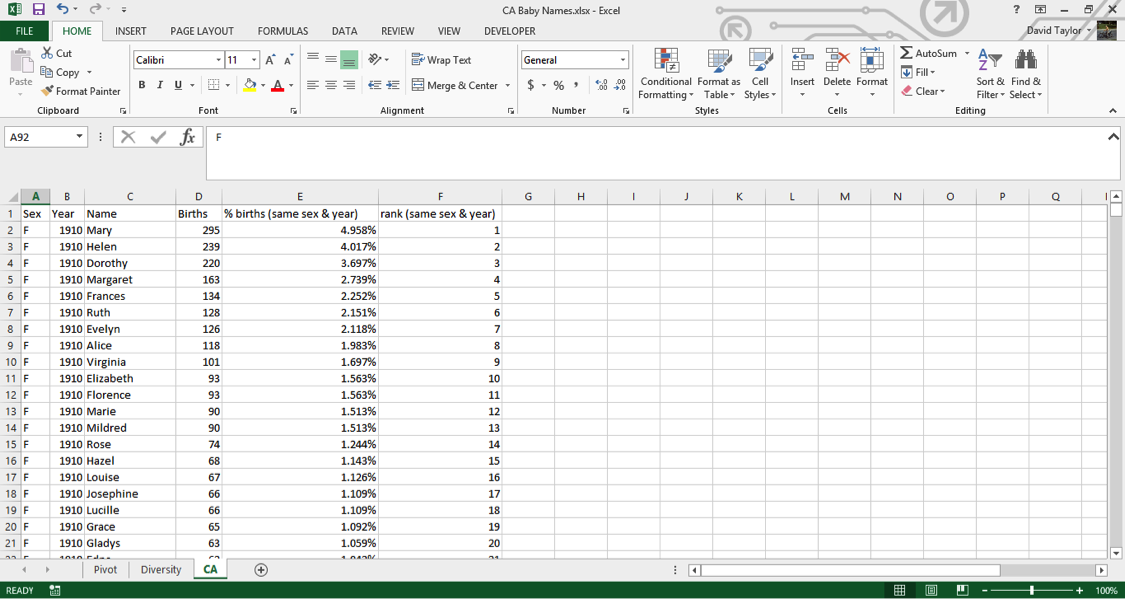
Visualize your data
Now that you have these calculated columns, y'all can utilize filters as yous did above to find the top names in each year. Select Columns A:F, and in the HOME tab, under Sort & Filter, choose Filter.
At present click the filter icon in cell F1 and select only the names of rank one (i.due east. the #1 names of each sex of each year). Yous can see that Mary dominates until the 1930s. Then Mary, Barbara and Linda alternate until Linda wins out for x years. Lisa, Jennifer, Jessica and Emily have solid runs later on on, so Isabella and Sophia are the meridian name for iii years each. Amid the boys, John, Robert, David, Michael and Daniel give style to Jacob for the last few years.
If you look at the percentage column, yous tin can meet that the #1 name takes up a smaller and smaller part of all the names as the years become past. This is further testify of the increasing diversity of names over time, and different the multifariousness measure out y'all calculated before, nothing unexpected happens in the early role of the dataset.
Now you tin utilise the filter tool to visualize individual names. The beginning thing to do is sort the names; this extra footstep will brand it possible to make charts of the results. Be warned, with over 300,000 rows, this could take a few minutes depending on the power of your reckoner, but it only has to be done once. Click on the filter icon in the Names column header, and choose Sort A to Z.
Once the sort is completed, use the filters to cull 'F' for sexual practice and 'Heather' for name, then employ theCtrl/Cmd key to select the yr and percentage values in Columns B and Due east, respectively. Insert a chart, and you should see the following:
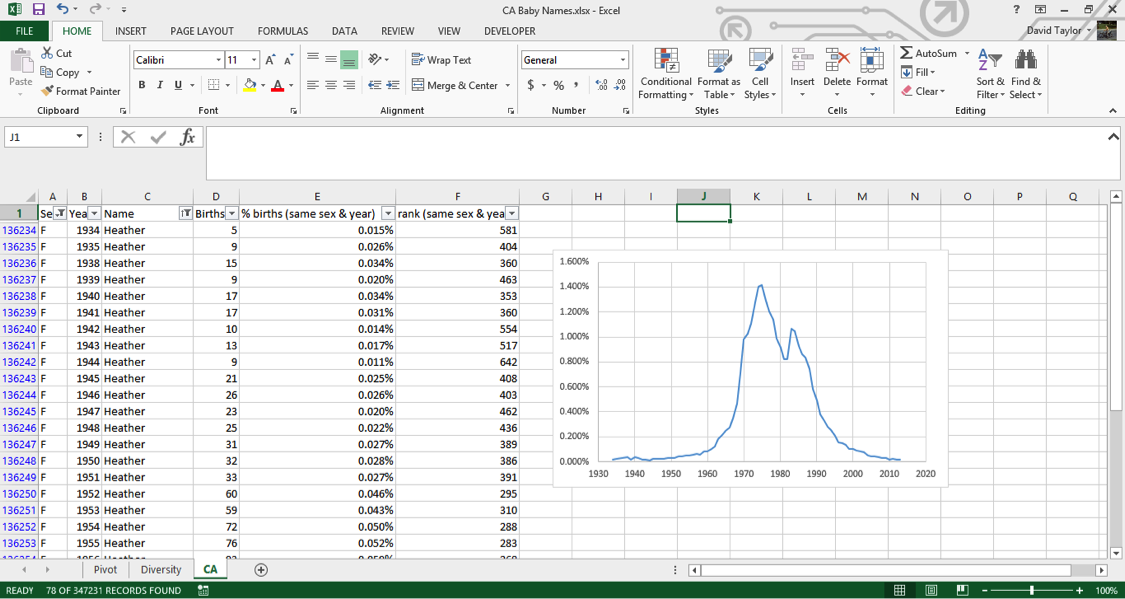
If you explore these names, you'll see this sort of pattern more often with girls' names than boys' names: a quick ascension from obscurity to popularity, then equally the name becomes too trendy, a descent to obscurity once again. The closest parallel you can see with boys' names is a more general blueprint, those of names ending in 'n'. Await up names like Bricklayer, Ethan and Jayden, you'll see them all ascent from obscurity to prominence in the 2000s, and many of them are only starting to dip again as of 2022. Beneath is the simple representation for the Distribution of last letter in Newborn boys names.
Remember what was written above about much of this dataset being adult names instead of baby names, because babies only routinely had Social Security numbers starting in 1986? You can see this in the data as well. For instance, a baby would be much more than likely to have the name "Peter" on his official documents than the nickname "Pete". Just if, when a young human or older filled out a revenue enhancement return or practical for Social Security, he would be more likely to use the name he went by in mean solar day-to-twenty-four hour period life, which might be a nickname he'd been chosen since he was a boy. You tin can filter the sex for M and the names for 'Pete' and 'Peter', and either brand ii charts or put the series on the same chart. Putting 2 series from the same column on i chart involves using the Select Data chart context bill of fare item, which is beyond the scope of this tutorial, but it'south non that difficult. Take a look at the consequence:
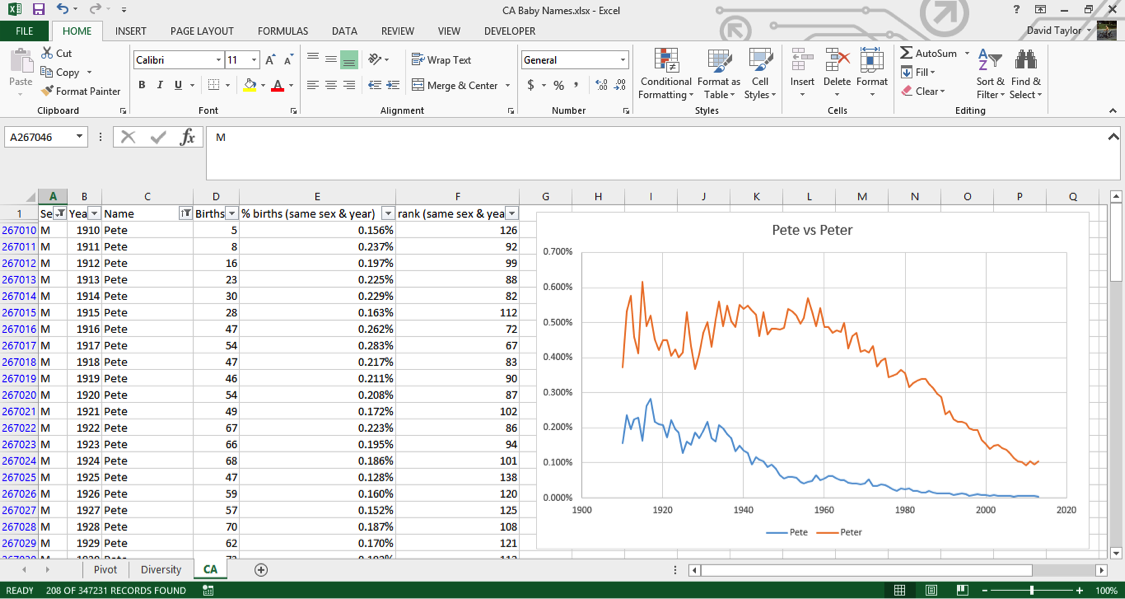
In the beginning of the dataset, 'Pete' is about half as pop as 'Peter'. Starting at almost exactly 1937 when Social Security numbers were introduced, 'Pete' starts a reject in popularity while 'Peter' stays relatively abiding – this indicates that people are starting to put their birth names on Social Security applications. The decline of 'Pete' bottoms out at nigh exactly 1986, when it became commonplace for babies to have Social Security numbers.
Hopefully, you establish this tutorial enjoyable and interesting. The important lessons to take away from this are that you can manipulate large datasets in Microsoft Excel, and datasets oft aren't exactly what they seem!
Source: https://world wide web.udemy.com/advanced-microsoft-excel-2013-online-excel-course/#exceltutorial
How To Work With Large Data Sets In Excel,
Source: https://www.excelforcommerce.com/analyze-large-data-sets-in-excel/
Posted by: dolanadvigul.blogspot.com


0 Response to "How To Work With Large Data Sets In Excel"
Post a Comment